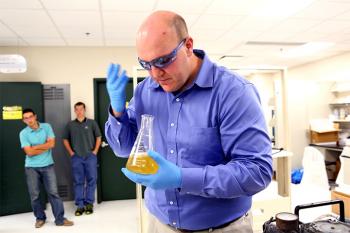 A mechanical engineering professor at Ohio University’s Russ College of Engineering and Technology has received a $2.9 million award to test his novel hydraulic fracturing wastewater treatment method on a commercial scale.
A mechanical engineering professor at Ohio University’s Russ College of Engineering and Technology has received a $2.9 million award to test his novel hydraulic fracturing wastewater treatment method on a commercial scale.
Supported by funds from Ohio Third Frontier, Ohio University, and partner companies RF Advanced Technologies Group and Babcock & Wilcox, Associate Professor of Mechanical Engineering Jason Trembly will expand his team’s laboratory-scale prototype to a commercial-sized unit capable of cleaning hydraulic fracturing wastewater onsite, reducing the expense and risks associated with current trucking and disposal methods.
“We want to take that unit out into the field, operate it, show that it works and, pending successful results, then be able to commercialize the technology,” said Trembly, who is also associate director of the Ohio Coal Research Institute.
Design and construction of the team’s current prototype was funded by $2 million in federal and state grants from the Research Partnership to Secure Energy for America. Trembly’s new award signals the state and industry’s continued hope that his method can bring efficiency to one of fracturing’s largest operational costs and one of the public’s greatest concerns – water.
One shale gas well requires 4-6 million gallons of water, much of which is returned to the surface as “flowback,” a mixture of water, salts, hydrocarbons, and a variety of other contaminants. Currently, flowback is transported to injection wells for disposal.
“The real problem is shipping that waste to an injection well,” Trembly explained. “Having to travel long distances, you’re expending a lot of energy and fuel costs to dispose of that water, so it’s really expensive.”
The multi-step process begins with ultraviolet and water-softening technologies that remediate bacteria and remove hard-water ions. Then, the mixture is heated under high pressure in a reactor, which moves it into a supercritical state to allow the contaminants to either precipitate out as solids or gasify, leaving only clean water.
That clean water can then be added back into the watershed or reused in further well development. But clean water isn’t the system’s only valuable output. The other is salt.
“You could take this salt and use it in roadway or other industrial applications, because we remove the hazardous components up front.”
The project’s efficient use of byproducts, innovative design and diverse potential applications is in part why Ohio Third Frontier made its $1.45 million investment as part of its Innovation Platform Program, which seeks to bring emerging technologies with strong potential for economic development in the state to market.
If the system can operate successfully at commercial scale, Trembly foresees the technology being useful in a variety of applications beyond the hydraulic fracturing industry.
“A couple of the other things we’re looking at are treatment of farm animal waste and also emergency water supplies,” Trembly explained. “For example, the issue in Toledo with toxins from cyanobacteria, or in Charleston, West Virginia’s recent chemical spill – we can actually take that water and destroy whatever those toxic components may be and produce a potable water product.”
From WOUB News | April 27, 2015




